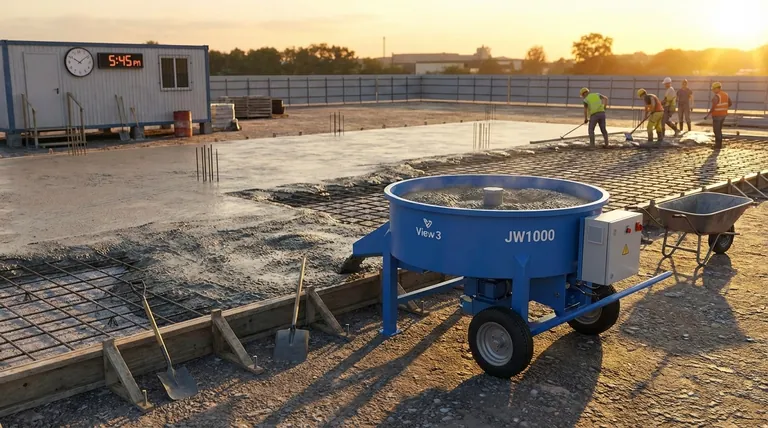As a general rule, you have approximately one hour from the moment you add water to mix, transport, and place your concrete. This working window, often called "pot life," is dictated by the chemical reaction that causes concrete to harden, and exceeding it can severely compromise the structural integrity of your project.
The critical factor isn't just the mixing time but the entire window of workability. Your goal is to get the concrete fully placed and consolidated before it begins to set, preventing weak points known as cold joints.

Why Time is Your Critical Constraint
The one-hour guideline isn't arbitrary; it's based on the fundamental chemistry of concrete. Understanding this process is key to preventing costly failures.
The Hydration Process Begins Immediately
The moment water is added to Portland cement, a chemical reaction called hydration begins. This process forms crystalline structures that interlock and bind the aggregates (sand and gravel) together, giving concrete its strength. This reaction is irreversible and starts immediately.
Understanding "Pot Life"
"Pot life" or "workability time" refers to the period during which the concrete mixture remains fluid and plastic enough to be poured, moved, and finished. As hydration progresses, the mix becomes progressively stiffer and more difficult to work with.
The Danger of Cold Joints
A cold joint is a critical flaw that occurs when a fresh batch of concrete is poured against a previous batch that has already started to harden. Because the two layers don't interlock chemically, a weak seam is created, which can allow water intrusion and lead to cracking and structural failure. Sticking to the one-hour window for mixing and placing ensures your entire pour cures as a single, solid mass.
Factors That Change Your One-Hour Window
While one hour is a reliable rule of thumb, it's not absolute. Environmental conditions and the mix itself can dramatically alter your available working time.
Temperature and Humidity
Heat is an accelerator. On a hot, sunny, or windy day, evaporation and the chemical reaction speed up, significantly shortening your workability time. You may have as little as 30-45 minutes. Conversely, cool and damp conditions will slow hydration, potentially extending your working time.
The Water-to-Cement Ratio
While it might be tempting to add more water to keep a mix workable, this is a common and critical mistake. A higher water-to-cement ratio creates a weaker, more porous final product.
Concrete Admixtures
For professional or large-scale jobs, chemical admixtures can be used. Retarders are specifically designed to slow the hydration process, extending the pot life for complex pours or hot weather. Accelerators do the opposite, speeding up the cure time in cold conditions.
Common Pitfalls to Avoid
Time pressure can lead to poor decisions on the job. Being aware of these common mistakes is crucial for ensuring a durable result.
The Mistake of Over-Mixing
Continuous mixing does not extend the workability window. In fact, mixing for too long can be detrimental. It can break down aggregates, introduce excessive air into the mix, and actually accelerate water evaporation, all of which weaken the final concrete. Mixing should be just long enough to achieve a uniform consistency—typically 3-5 minutes.
The Temptation of "Re-tempering"
If your concrete mix begins to stiffen in the wheelbarrow, do not add more water to make it workable again. This practice, known as re-tempering, disrupts the crystalline structure that has already begun to form. It will permanently compromise the concrete's designed strength and durability.
Planning Your Pour for Success
Your approach should be dictated by the scale of your project and your working conditions. Always have everything prepared before you start mixing.
- If your primary focus is a small project (like a fence post): The one-hour rule is a safe and reliable guide for ensuring a strong result.
- If your primary focus is a larger pour (like a small slab): Plan to mix and pour continuously, ensuring each new batch is placed and integrated well within the one-hour window of the first batch.
- If your primary focus is working in hot weather: Drastically shorten your expected work time and consider pouring in the cooler parts of the day.
Ultimately, respecting the concrete's chemical clock is the foundation of strong, reliable work.
Summary Table:
| Factor | Effect on Workability Time |
|---|---|
| High Temperature | Decreases (30-45 minutes) |
| Low Temperature | Increases (over 60 minutes) |
| High Water-to-Cement Ratio | Weakens final strength (Not Recommended) |
| Retarder Admixture | Increases (for complex/hot weather pours) |
| Accelerator Admixture | Decreases (for cold weather pours) |
Ensure a perfect pour every time with GARLWAY machinery.
Our robust and reliable concrete mixers and batching plants are engineered to deliver consistent, high-quality batches, helping you efficiently manage the critical workability window. For construction companies and contractors working on projects of any scale, GARLWAY equipment is your partner in achieving durable, structurally sound results.
Contact our experts today to find the ideal concrete mixing solution for your next project!
Visual Guide

Related Products
- Ready Mixer Machine for Construction Ready Mix Machinery
- Commercial Construction Mixer Machine for Soil Cement Mixing Concrete
- Portable Concrete Mixer Machine Equipment for Mixing Concrete
- Concrete Cement Mixer Machine Drum Mixer for Construction
- HZS25 Best Cement Mixer for Quick Mix Concrete at Bunnings
People Also Ask
- Why is cleaning a concrete mixer after use important? Avoid Costly Repairs and Ensure Quality
- Can a concrete mixer be used for mortar? Understanding the trade-offs for your project
- Why is the manufacturer's strength and service important when choosing a concrete mixer? Ensure Long-Term Project Success
- What safety considerations are important for concrete mixer operation? A Guide to Proactive Risk Management
- What should be considered regarding the output of a concrete mixer? Match Capacity to Your Project Scale



















